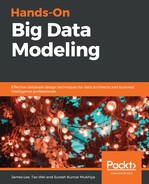Consider the following JSON snippet:
{
"id":101,
"name":"John Doe",
"nickname":"John",
"username":"johndoe",
"email" : "[email protected]",
"createdAt":"2018-08020T10:10:00",
"friendIds":[
2,
3,
4,
10
],
"employement":[
{
"organizationName":"SAS Web Tech",
"startDate":"2017-08-06"
},
{
"organizationName":"Kirlosker Service Center",
"startDate":"2016-08-06"
}
],
"gender":"Male"
}
The JSON data holds information of an employee who has a name, nickname, and username, and the date when the record was inserted. An employee can be associated with one or more organizations. To create a schema in AsterixDB, our schema could appear as follows:
create type EmploymentType as closed {
organizationName: string,
startDate: date,
endDate: date?
};
Notice that the schema is defined as closed. Now we can define UserType as follows:
create type UserType as open {
id: int,
username: string,
name: string,
email: string,
nickname: string,
createdAt: datetime,
friendIds: {{ int }},
employment: [EmploymentType],
gender: string
};
The world of data in AsterixDB is organized into data namespaces called dataverses. To set default dataverses for a series of statements, the use dataverse statement is provided. For example, to use dataverse to be TinySocial, we need to execute the following statement:
$ use dataverse TinySocial;
Now create dataset is used to create a new dataset. To create a dataset for this example, we need to run the following statements:
$ create dataset Employee(UserType) primary key id;
After that, we can create the example UserType and EmploymentType. When you run these statements, the output screen should look something like this:

